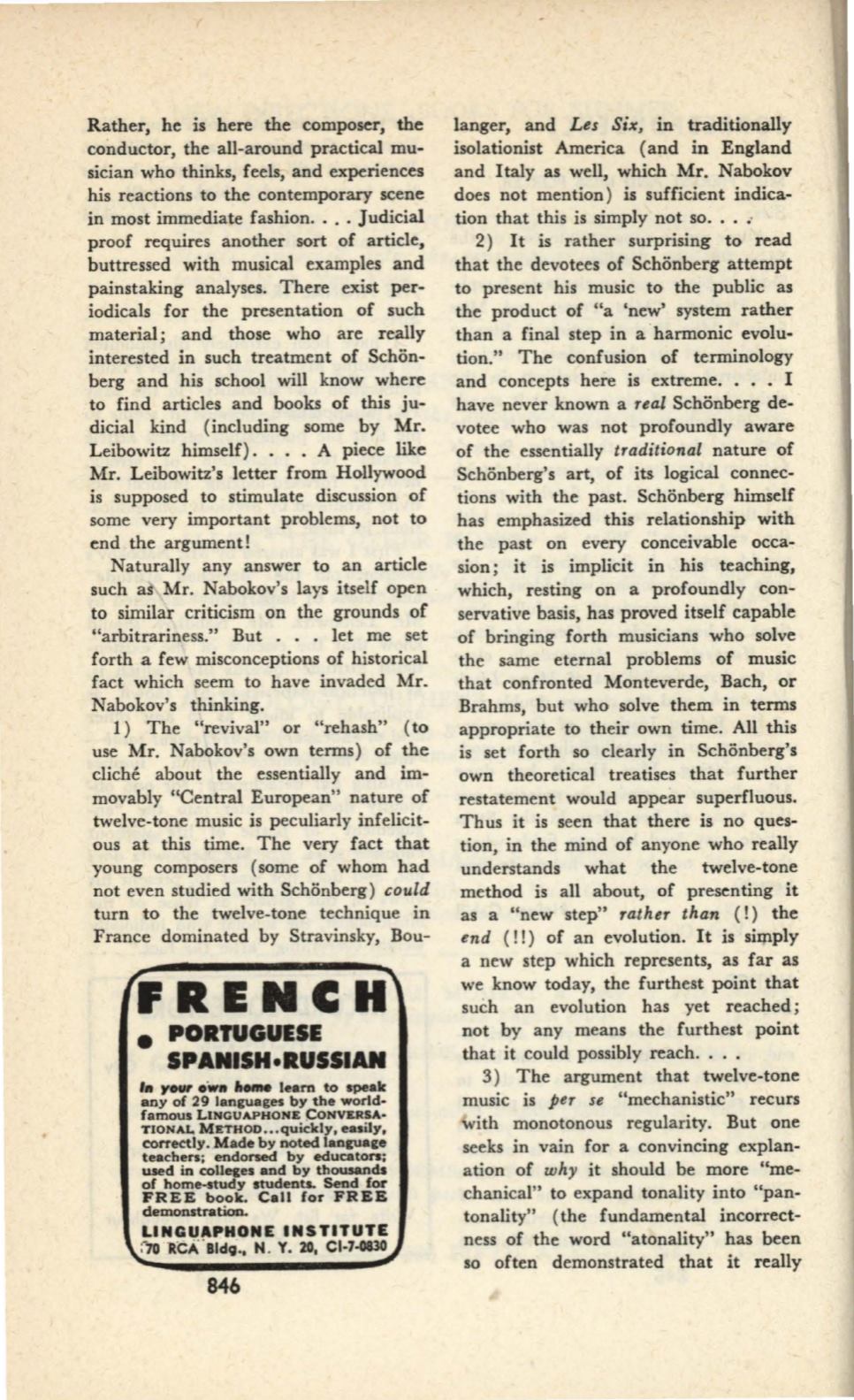
Rather, he is here the composer, the
conductor, the all-around practical mu–
sician who thinks, feels, and experiences
his reactions to the contemporary scene
in most immediate fashion.... Judicial
proof requires another sort of article,
buttressed with musical examples and
painstaking analyses. There exist per–
iodicals for the presentation of such
material; and those who are really
interested in such treatment of Schon–
berg and his school will know where
to find articles and books of this ju–
dicial kind (including some by Mr.
Leibowitz himself). . . . A piece like
Mr. Leibowitz's letter from Hollywood
is supposed to stimulate discussion of
some very important problems, not to
end the argument!
Naturally any answer to an article
such a Mr. Nabokov's lays itself open
to similar criticism on the grounds of
"arbitrariness." But . . . let me set
forth a few misconceptions of historical
fact which seem to have invaded Mr.
Nabokov's thinking.
1) The "revival" or "rehash" (to
use Mr. Nabokov's own terms) of the
cliche about the essentially and im–
movably "Central European" nature of
twelve-tone music is peculiarly infelicit–
ous at this time. The very fact that
young composers (some of whom had
not even studied with Schonberg)
could
turn to the twelve-tone technique in
France dominated by Stravinsky, Bou-
FRENCH
e
PORTUGUESE
SPANISH•RUSSIAN
Ia your
own ,....,.
team
to speak
any of 29 languages by the world·
famous LINGUAPHONE CONVERSA·
TIONA!., METHOD•••quickly, easily,
cotTectly. Made by noted
langua~~:e
teachers; endoned
by
educators;
used in
colle~~:es
and by thousands
of home-study students. Send for
FREE
book. Call for
FREE
demonstration.
LINGUAPHONE INSTITUTE
:·70
lt"CA'
Bld9·., N. Y. 20, Cl·7·0830
846
Ianger, and
Les Six,
in traditionally
isolationist America (and in England
and Italy as well, which Mr. Nabokov
does not mention) is sufficient indica–
tion that this is simply not so...•.
2) It is rather surprising to read
that the devotees of Schonberg attempt
to present his music to the public as
the product of "a 'new' system rather
than a final step in a harmonic evolu–
tion." The confusion of terminology
and concepts here is extreme. . • . I
have never known a
real
Schonberg de–
votee who was not profoundly aware
of the essentially
traditional
nature of
Schonberg's art, of its logical connec–
tions with the past. Schonberg himself
has emphasized this relationship with
the past on every conceivable occa"
sion; it is implicit in his teaching,
which, resting on a profoundly con–
servative basis, has proved itself capable
of bringing forth musicians who solve
the same eternal problems of music
that confronted Monteverde, Bach, or
Brahms, but who solve them in terms
appropriate to their own time. All this
is set forth so clearly in Schonberg's
own theoretical treatises that further
restatement would appear superfluous.
Thus it is seen that there is. no ques–
tion, in the mind of anyone who really
understands what the twelve-tone
method is all about, of presenting it
as a "new ·step"
rather than
(!) the
end
(!!) of an evolution. It is simply
a new step which represents, as far as
we know today, the furthest point that
such an evolution has yet reached;
not by any means the furthest point
that
it
could possibly reach....
3) The argument that twelve-tone
music is
per se
"mechanistic" recurs
with monotonous regularity. But one
seeks in vain for a convincing explan–
ation of
why
it should be more "me–
chanical" to expand tonality into "pan–
tonality" (the fundamental incorrect–
ness of the word "atonality" has been
so often demonstrated that it really


